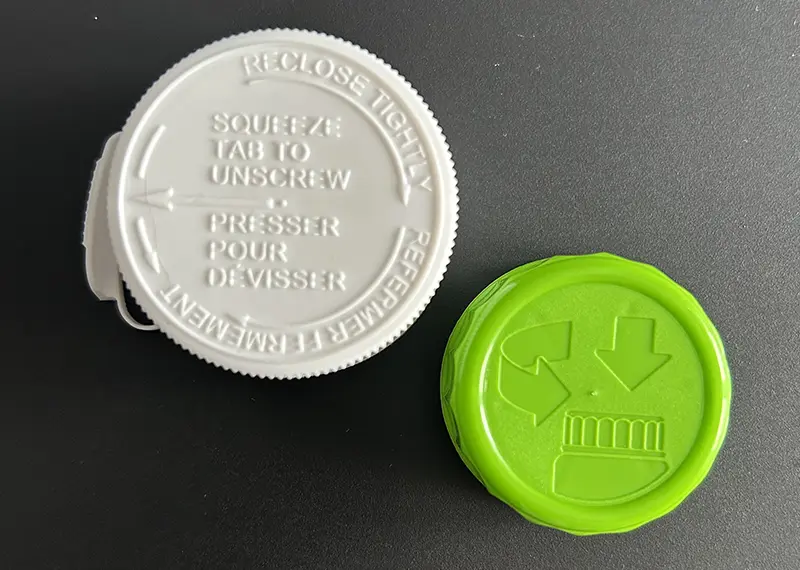Whether in Canada under the CCCR, in the United States under the CPSC or Europe under the CLP, child-resistant containers are an important regulatory element in the sale of hazardous consumer products. They are designed to be difficult for a child to open, but easy for an adult to do so. This type of container helps protect children who are too young to understand the risks associated with a hazardous product.
Types of Child-Resistant Containers
Child-resistant containers can generally be divided into two broad categories: reclosable containers and single-use containers.
Reclosable Containers
Reclosable containers are those that contain a product in a quantity greater than what is needed for a single-use of the product. These containers have a cap that requires a special technique to open. A common example is the "Squeeze tab to unscrew" cap. After the first use of the product, the container can be closed again, and it will retain its child-resistant properties throughout its useful life.
Single-Use Containers
As the name suggests, these containers are designed to be used up when opened. Therefore, they must be supplied in quantities appropriate for single use. These types of containers require a destructive action on the container to open, such as piercing it with a tool. Once opened, the container no longer retains its child-resistant properties.
Under the CCCR
In Canada, the Consumer Chemicals and Containers Regulations (CCCR) require child-resistant containers based on the classification of the hazardous product.
When are child-resistant containers required?
These regulations stipulate that the use of these containers is compulsory for chemicals that belong to any of the following categories:
- Corrosive
- Very corrosive
- Toxic
- Very toxic
- Quick skin-bonding adhesive
All products sold in containers of 5 litres or less must meet this requirement. Containers holding more than 5 litres are subject to the same rules as those under 5 litres for the following product categories:
- Quick skin-bonding adhesive
- Very corrosive
Standard for child-resistant containers
To comply with Canadian regulations, the child-resistant container must meet one of the following two conditions:
- Meet the requirements of the testing programs of one of the following standards:
- CSA-Z76.1
- ISO 8317
- 16 CFR 1700.20
- An equivalent or higher standard
- Require, in order to be opened, the perforation or removal of one of its functional and necessary parts using a tool not provided.
Under the CPSC
In the United States, the Consumer Product Safety Commission (CPSC) requires, by regulation, that child-resistant containers be used for products containing certain substances.
When are child-resistant containers required?
Unlike in Canada, the use of these containers does not depend on the classification of the product, but directly on its list of ingredients.
The exact list of substances requiring the use of a child-resistant container is presented in 16 CFR § 1700.14. In some cases, the items on this list are very specific chemicals, such as:
- Sodium hydroxide
- Potassium hydroxide
- Methyl alcohol
- Ethylene glycol
- Sulfuric acid
- Etc.
In some cases, the items on the list are more general, targeting a category of products. For example:
- Medicines containing iron
- Furniture polish
- Mouthwash
- Etc.
It is therefore very important, for sale in the United States, to consult this list carefully to determine whether the product is subject to the requirement of a child-resistant container.
Child-Resistant Container Standard
Child-resistant containers in the United States must pass the test protocol set out in 16 CFR § 1700.20.
Under the CLP
The requirements for child-resistant containers in Europe are set out in the Containers, Labelling and Packaging (CLP) Regulation, Section 3.1 of Annex II.
When are child-resistant containers required?
This section specifies the requirement to use a child-resistant container if the product falls into one of the following hazard classes:
- Acute toxicity, categories 1 to 3 (regardless of route)
- Specific target organ toxicity — single exposure, category 1
- Specific target organ toxicity — repeated exposure, category 1
- Skin corrosion, category 1
- Aspiration hazard, except for products in aerosols or sealed spray
In addition, products containing certain specific substances must also be sold in a child-resistant container. These substances are:
- Methanol at a concentration of 3% or more,
- Dichloromethane at a concentration of 1% or more.
Child-resistant container standard
Child-resistant containers must have been tested to one of the following two standards by a laboratory accredited under ISO 17025:
- ISO 8317 for reclosable containers
- CEN EN 862 for single-use containers
Despite this requirement, if the container cannot be opened without a tool, testing may be omitted.
Conclusion
While the details differ from one regulation to another, a common element is present in each: the obligation to protect children when the hazardous material is deemed to pose a significant risk. Whether based on the presence of a risky ingredient or on the properties of the mixture, the desire to protect vulnerable people is present in Canada, the United States and Europe.
However, these differences can make exports complex. Regulatory differences may make a chemical acceptable in standard packaging in one location but require a child-resistant container in another country. If you need help selling your products, don't hesitate to call the experts at Kalium Solutions!





